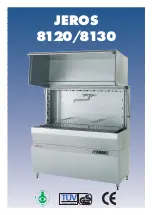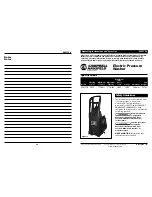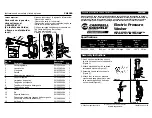
setting up your washer
_15
setting up your washer
_15
MEETING INSTALLATION REQUIREMENTS
Electrical supply and grounding
To prevent unnecessary risk of fire, electrical shock, or personal injury, all wiring and grounding
must be done in accordance with the National Electrical Code ANSI/FNPA, No. 70 Latest
Revision and local codes and ordinances. It is the personal responsibility of the appliance owner
to provide adequate electrical service for this appliance.
Never use an extension cord.
Use only the power cord that comes with your washer.
When preparing for the installation, ensure that your power supply off ers:
•
A fuse or circuit breaker
•
An Individual branch circuit serving only your washer
Your washer must be grounded. If your washer malfunctions or breaks down, grounding will
reduce the risk of electric shock by providing a path of least resistance for the electric current.
Your washer comes with a power cord having a three-prong grounding plug for use in a properly
installed and grounded outlet.
Never connect the ground wire to plastic plumbing lines, gas lines, or hot water pipes.
Improperly connecting the equipment-grounding conductor can result in electrical shock. Check
with a qualifi ed electrician or service person if you question whether the washer is properly
grounded. Do not modify the plug provided with the washer. If it does not fit the outlet, have a
proper outlet installed by a qualifi ed electrician.
Water supply
Your washer will fi ll properly when your water pressure is 0.05 MPa~0.78 Mpa (0.5~8.0 kg·f/cm
2
).
Water pressure less than 0.05 MPa (0.5 kg·f/cm
2
) may cause a water valve failure, not allowing the
water valve to shut off completely. Or it may take the washer longer to fi ll than what the controls
allow, resulting in your washer turning off . (A fi ll-time limit, designed to prevent overfl ows/fl ooding if an
internal hose becomes loose, is built into the controls.)
The water faucets must be within 4 feet (122 cm) of the back of your washer for the provided inlet
hoses provided to reach your washer.
You can reduce the risk of leaks and water damage by:
• Making water faucets easily accessible.
• Turning
off faucets when the washer is not in use.
• Periodically checking for leaks at the water inlet hose fi ttings.
Before using your washer for the first time, check all connections at the water valve and faucets for
leaks.
Flooring
For best performance, your washer must be installed on a solidly constructed fl oor.
Never install your washer on a platform or poorly supported structure.
01 SETTING UP Y
OUR W
ASHER
WA17GWGIH-02685M_EN.indd Sec3:15
WA17GWGIH-02685M_EN.indd Sec3:15
2011-12-06 3:39:26
2011-12-06 3:39:26
















































